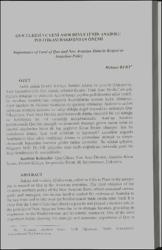Que Ülkesi ve Yeni Asur Devlet'nin Anadolu Politikası Bakımından Önemi
Özet
Antik çağda Ovalık Kilikya denilen Adana ve çevresi (Çukurova),
Asur kaynaklarında Que olarak adlandırılmıştır. Yeni Asur Devleti’nin çok
değişik amaçlar ve stratejiler içeren kuzey yayılım politikasının nihaî hedefi,
bir taraftan Anadolu’nun zenginlik kaynaklarını sonuna kadar sömürme,
diğer taraftan da Akdeniz ticaretini ele geçirme olmuştur. Akdeniz’e açılım
sağlayan stratejik konumu ve sahip olduğu doğal kaynakları nedeniyle Que
Ülkesi’nin, Yeni Asur Devleti politikalarında daima öncelikli bir yer tuttuğu
ve belirleyici bir rol oynadığı anlaşılmaktadır. Asur’un Anadolu
politikasında Que’nin stratejik ve ekonomik önemini gözler önüne seren en
önemli olaylardan birisi de hiç şüphesiz Kirua İsyanı olmuştur. İşte bu
makalenin amacı, Asur kral yıllıkları ve hiyeroglif kaynaklar ışığında
Asurluların Que adını verdikleri Adana ve çevresinin stratejik ve sosyoekonomik
bakımdan önemini gözler önüne sermektir. Bu açıdan çalışma,
bölgenin M.Ö. IX.-VII. yüzyıllar arası tarihi coğrafyası hakkında genel bir
değerlendirmeyi de içermektedir. Adana and vicinity (Çukurova), called as Cilicia Plain in the antique
era is named as Que in the Assyrian resources. The final objective of the
invasive northern policy of the New Assyrian State, which contained various
goals and strategies, was in one hand to exploit the richness of Anatolia to
the last limit and to take over the Mediterranean trade on the other hand. It is
clear that the Land of Que had always a priority and played a decisive role in
the policies of New Assyrian State due to its strategic location, providing an
expansion to the Mediterranean and its natural resources. One of the most
important events showing the strategic and economic importance of Que in the Anatolian policy of Assyrian State was doubtless the Rebellion of Kirua.
The objective of this article is to unfold the strategic and socio-economic
importance of Adana and vicinity, which the Assyrians called Que according
to the almanacs of the Assurian kings and hieroglyph resources. In this
respect, the study includes also a general assessment of the historical
geography of the region between IX.-VII. Centuries B.C.
Kaynak
Sosyal Bilimler DergisiCilt
10Sayı
3Bağlantı
http://hdl.handle.net/11630/3742Koleksiyonlar
- Cilt 10 : Sayı 3 [14]



















